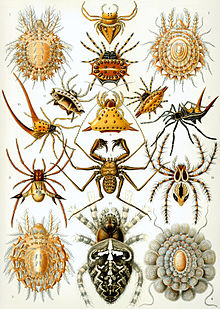Arachnids
| Arachnids Temporal range: 430–0 Ma Early Silurian – Recent |
|
|---|---|
 |
|
| "Arachnida" from Ernst Haeckel's Kunstformen der Natur, 1904 | |
| Scientific classification | |
| Kingdom: | Animalia |
| Phylum: | Arthropoda |
| Subphylum: | Chelicerata |
| Class: |
Arachnida Lamarck, 1801 |
| Orders | |
Arachnids are a class (Arachnida) of joint-legged invertebrate animals (arthropods), in the subphylum Chelicerata. All arachnids have eight legs, although the front pair of legs in some species has converted to a sensory function, while in other species, different appendages can grow large enough to take on the appearance of extra pairs of legs. The term is derived from the Greek word (aráchnē), meaning "spider".Spiders are the largest order in the class.
Almost all extant arachnids are terrestrial, living mainly on land. However, some inhabit freshwater environments and, with the exception of the pelagic zone, marine environments as well. They comprise over 100,000 named species, including spiders, scorpions, harvestmen, ticks, mites, and solifuges.
Almost all adult arachnids have eight legs, and arachnids may be easily distinguished from insects by this fact, since insects have six legs. However, arachnids also have two further pairs of appendages that have become adapted for feeding, defense, and sensory perception. The first pair, the chelicerae, serve in feeding and defense. The next pair of appendages, the pedipalps, have been adapted for feeding, locomotion, and/or reproductive functions. In Solifugae, the palps are quite leg-like, so that these animals appear to have ten legs. The larvae of mites and Ricinulei have only six legs; a fourth pair usually appears when they moult into nymphs. However, mites are variable: as well as eight, there are adult mites with six or even four legs.
...
Wikipedia
